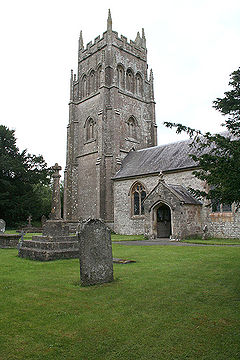Cranmore is a village and civil parish east of Shepton Mallet, in Somerset, England. The parish includes the hamlets of Waterlip, East Cranmore and Dean. In 2011 the parish had a population of 667.
| Cranmore | |
|---|---|
 | |
Location within Somerset | |
| Population | 667 (2011)[1] |
| OS grid reference | ST665435 |
| Unitary authority | |
| Ceremonial county | |
| Region | |
| Country | England |
| Sovereign state | United Kingdom |
| Post town | SHEPTON MALLET |
| Postcode district | BA4 |
| Dialling code | 01749 |
| Police | Avon and Somerset |
| Fire | Devon and Somerset |
| Ambulance | South Western |
| UK Parliament | |
History
editThe name comes from Crane Mere, the Lake of the Cranes.[2]
The parish of Cranmore was part of the hundred of Wells Forum.[3] East Cranmore was part of the hundred of Frome.[4]
It is the base of the East Somerset Railway which plays host to a variety of preserved diesel and steam locomotives. It operates the line between Cranmore railway station, Cranmore West, Merryfield Lane Halt, and Mendip Vale. The section between Cranmore and the mainline is used for heavy quarry traffic to the nearby Merehead Quarry. The quarry, which is also known as Torr Works, covers an area of some 200 hectares, including 60 hectares which have been landscaped to blend with the surrounding countryside. It was once operated by the Foster Yeoman Company, but is now owned and operated by Aggregate Industries LTD, employing over 200 people and produces 6 million tonnes of limestone annually which is carried directly from the quarry by Mendip Rail.
Cranmore Hall is a large 17th-century country house with landscaped gardens which now forms the main portion of All Hallows Preparatory School.[5] Southill House is a smaller country house dating from the early 18th century which was refaced by John Wood, the Younger.[6]
Dean farmhouse dates from the 17th century,[7] as does The Old Smithy, just off the A361 which was originally two residential dwellings before being finally "knocked through" to just one.[8]
On a hill north of the village is the 45 metres (148 ft) tall Victorian folly, Cranmore Tower, built in 1862–64 by Thomas Henry Wyatt for John Moore Paget. The site is 280 metres (919 ft) above sea level, and is the highest point on the Mendip Way.
Governance
editThe parish council has responsibility for local issues, including setting an annual precept (local rate) to cover the council's operating costs and producing annual accounts for public scrutiny. The parish council evaluates local planning applications and works with the local police, district council officers, and neighbourhood watch groups on matters of crime, security, and traffic. The parish council's role also includes initiating projects for the maintenance and repair of parish facilities, as well as consulting with the district council on the maintenance, repair, and improvement of highways, drainage, footpaths, public transport, and street cleaning. Conservation matters (including trees and listed buildings) and environmental issues are also the responsibility of the council.
Until 2023 it was in the Non-metropolitan district of Mendip, which was formed on 1 April 1974 under the Local Government Act 1972, having previously been part of Shepton Mallet Rural District.[9] Cranmore is in the electoral ward called Cranmore, Doulting and Nunney. At the 2011 Census this had a population of 2,374.[10]
Somerset Council is responsible for running the largest and most expensive local services such as education, social services, libraries, main roads, public transport, policing and fire services, trading standards, waste disposal and strategic planning.
It is also part of the Frome and East Somerset county constituency represented in the House of Commons of the Parliament of the United Kingdom. It elects one Member of Parliament (MP) by the first past the post system of election, and was part of the South West England constituency of the European Parliament prior to Britain leaving the European Union in January 2020, which elected seven MEPs using the d'Hondt method of party-list proportional representation.
Landmarks
editSouthill House is an early 18th-century manor house south of the main village. It was given a new facade by John Wood, the Younger, of Bath, in the late 18th century.[11]
Close to Cranmore is a small lake called Torr Works Reservoir which attracts large numbers of roosting gulls.
Religious sites
editThe Church of St Bartholomew dates from the 15th century and has been designated by English Heritage as a Grade I listed building.[12] The former church of St James in East Cranmore has been deconsecrated and is now used as a private dwelling.[13]
References
edit- ^ "Cranmore Parish". Neighbourhood Statistics. Office for National Statistics. Retrieved 1 January 2014.
- ^ "Cranmore". Cranmore village website. Archived from the original on 1 August 2012. Retrieved 14 November 2010.
- ^ "Somerset Hundreds". GENUKI. Retrieved 12 September 2011.
- ^ "Somerset Hundreds". GENUKI. Retrieved 8 October 2011.
- ^ Historic England. "Cranmore Hall, walling and gazebo, now part of All Hallows School (1058533)". National Heritage List for England. Retrieved 25 March 2008.
- ^ Historic England. "Southill House and outbuildings (1058567)". National Heritage List for England. Retrieved 25 March 2008.
- ^ Historic England. "Dean Farmhouse (1058531)". National Heritage List for England. Retrieved 1 February 2008.
- ^ Historic England. "The Old Smithy (1345161)". National Heritage List for England. Retrieved 1 February 2008.
- ^ "Shepton Mallet RD". A vision of Britain Through Time. University of Portsmouth. Retrieved 4 January 2014.
- ^ "Cranmore, Doulting and Nunney Ward population 2011". Retrieved 23 October 2015.
- ^ Historic England. "Southill House and outbuildings (1058567)". National Heritage List for England. Retrieved 19 May 2009.
- ^ Historic England. "Church of St Bartholomew (1058528)". National Heritage List for England. Retrieved 25 March 2008.
- ^ Historic England. "Church of St James (1058534)". National Heritage List for England. Retrieved 25 March 2008.
